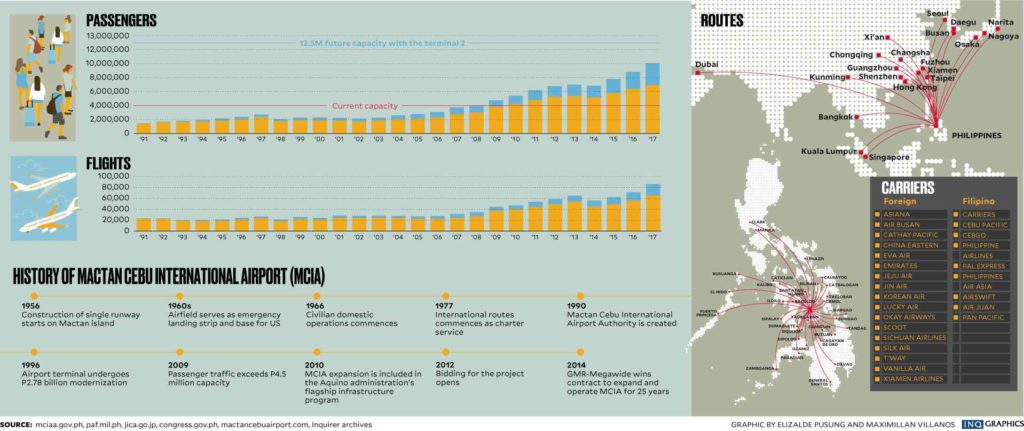Mactan’s maiden flight
(First of two parts)
Construction of an airport in the island of Mactan in Cebu began in 1956 when the United States Air Force built an airfield that would serve as an emergency landing strip for US bombers.
At that time, studies have been initiated to assess the potential value of Mactan as a possible alternate airport for the Civil Aeronautics Administration and the Philippine Air Force.
Then Defense Secretary Eulogio Balao, reporting to President Ramon Magsaysay in a meeting, said that the landing field in Mactan island was being considered because it can accommodate larger type planes. Balao added that hazards at the Cebu airport (Lahug Airport) made it necessary to look for possible substitute landing fields in case the Cebu airport would have to be transferred.
Originally named Mactan Air Base, the landing field was used as an outpost by the Americans until the Vietnam War when it became an air transit point for US troops and supplies bound for the war zone.
In the 1960s, the airfield became a joint military and civil airfield.
In April 1966, Mactan Airport started its domestic civil operations, sharing the single runway with the air base, now known as Mactan-Benito Ebuen Air Base. Mactan Airport replaced the Lahug Airport which had suffered safety and space constraints.
International air routes of Mactan-Cebu International Airport commenced as a charter service in 1978.
Republic Act No. 6958 enacted in 1990 created the charter of Mactan-Cebu International Airport Authority (MCIAA). The law also transferred the assets of the Mactan International Airport and the Lahug Airport to MCIAA, a government-owned and controlled corporation and attached agency of the Department of Transportation.
In 1996, under a P2.78 billion modernization project funded by Japan’s Overseas Economic Cooperation Fund, Mactan-Cebu International Airport upgraded its terminal with facilities at par with world standards and regulations.
As more tourists and investors flocked to Cebu, which became a natural hub for air and sea traffic to the Visayas and Mindanao, the airport congestion became a problem.
In 2005, then Transport Secretary Leandro Mendoza said that a new terminal was necessary to meet the expected growth in the number of passengers flying to and from Cebu to 5 million in the next five years.
However, pending the new terminal, the government banked on an expansion of the existing terminal.
In 2009, the airport recorded a passenger traffic, both domestic and international, of P4.8 million, exceeding its capacity of 4.5 million passengers. Total passengers reached over 5 million in 2010 and has been rising since. Last year, the number of international and domestic passengers reached more than 10 million.
In 2010, the Aquino administration launched its flagship infrastructure program called the PPP or the public-private partnership program. Among the big-ticket PPP projects was the proposed expansion of the Mactan-Cebu International Airport.
The project was opened for bidding in 2012. During the opening of the prequalifying documents in April 2013, seven groups expressed interest on the project. They were the MPIC-JGS consortium, AAA Airport Partners, Filinvest-CAI consortium, San Miguel-Incheon Airport consortium, First Philippine Airports, Premier Airport group and GMR Megawide consortium.
Behind those firms are some of the country’s most prominent business names, among them Manuel V. Pangilinan-led Metro Pacific Investments Corp. with Gokongwei-led JG Summit Holdings for MPIC-JGS, Ayala Corp. and Aboitiz Equity Ventures for AAA, Henry Sy’s SM Group for Premier Airport and the Lopez Group for First Philippine Airports.
It was the tandem of Filipino builder Megawide Construction Corp. and India’s GMR Infrastructure that won the P17.5-billion contract to expand and operate Mactan Cebu International Airport. GMR-Megawide Cebu Airport Corporation took over the management of the airport on Nov. 1, 2014 with the concession agreement lasting for 25 years.
Former Sen. Sergio Osmeña III and the Business for Progress Movement sought to stop the deal accusing the Transportation department of arbitrariness for its decision to award the contract to the GMR-Megawide consortium. The Supreme Court, however, has dismissed the consolidated petitions for lack of merit and legal factual bases. The high court pointed out that the government had the discretion in choosing who among the bidders can offer the most advantageous terms.
(To be continued)
Sources: Inquirer Archives, mciaa.gov.ph, paf.mil.ph, jica.go.jp, congress.gov.ph, mactancebuairport.com

